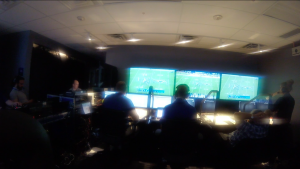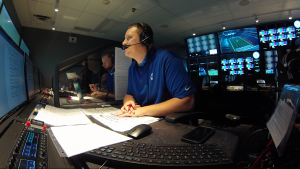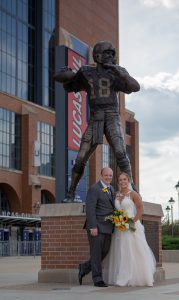On the Gridiron: Indianapolis Colts Handle Remote Radio Broadcasts of Away Games From Lucas Oil Stadium
The effort involves collaboration with the league, broadcasters, The Switch
Story Highlights
Many professional sports have opted for a return to play inside a sanitized bubble. Not the NFL. Without skipping a beat, the league is soldiering on with regular-season games in all 30 stadiums across the country. Similar to our At the Ballpark series, On the Gridiron examines the new routines, habits, and production philosophies of in-venue personnel on any given Thursday, Sunday, or Monday.
In consecutive home games, the Indianapolis Colts rattled off convincing wins against the Minnesota Vikings and New York Jets. A limited number of fans are enjoying amenities that they’re accustomed to on game day, but, when games aren’t played at Lucas Oil Stadium, the in-venue staff assists with remote radio broadcasts for away contests.
MORE ON THE GRIDIRON INTERVIEWS
- In Between Games, JungleVision Productions Sets the Table With Bengals Weekly
- Chicago Bears Fuel Content Train With Remote Workflows, Safe Crewing at Soldier Field
- Tennessee Titans’ Behind-the-Scenes Video Efforts Embodied by ‘Tennessee Tough’ Campaign
- Seattle Seahawks Production, Ops Teams Keep Fans at the Heart of Game Day at CenturyLink Field
- Silver and Black Productions, Las Vegas Raiders Build New Roots During Allegiant Stadium’s Inaugural Season
- Philadelphia Eagles Embrace Virtual Workflows for Efficient Regular-Season Strategy
- New York Giants Entertain At-Home Fans With Daily Digital, Linear Programming
- While SoFi Stadium Remains Empty, Los Angeles Chargers Refine Production Workflows
- Atlanta Falcons Adjust To Evolving COVID-19 Policies at Mercedes-Benz Stadium
- Minnesota Vikings Adjust Content Approach at High-Tech U.S. Bank Stadium
- How the Kansas City Chiefs Celebrated Super Bowl LIV, Displayed Moment of Unity Before Season Opener
- Carolina Panthers’ Mike Bonner Settles Into New Role Amid Interesting Circumstances
- Baltimore Ravens Adjust In-Game Operations To Feed More Content to Digital, Social Platforms
- After Busy Offseason, Denver Broncos Welcome Limited Fans Back to Empower Field at Mile High in Week 3
- San Francisco 49ers Production Team Shifts Gears To Engage the Players
- Jacksonville Jaguars Reflect on In-Stadium Fans During Week 1, Connecting With ‘Duval’ Community
- Without Raucous Crowds, New Orleans Saints Adapt to a Quiet Mercedes-Benz Superdome

While the football team is on the road, the Colts remotely produce radio broadcasts with the help of the NFL, broadcast networks, and The Switch.
“Our radio crew can’t travel this year, so I think a lot of other teams in the league are following this model as well,” says Mike Stevens, operations manager, video engineering, Indianapolis Colts. “It has been an interesting experience to say the least — especially for our talent, who have embraced the fact that they’re sitting in a control room hundreds of miles [from the action] but are still able to see what they need to see to efficiently call the game.”
Through the Speaker: Radio Broadcasts Continue Remotely
Even when the building isn’t packed with fans, the in-house production team is hard at work while the football team is on the road. In a season that has presented a hefty number of logistical challenges, production teams are confined to their respective stadiums to prevent a COVID-19 outbreak. When the Colts began their 2020 campaign in Jacksonville, FL, Stevens and his team leveraged a handful of partners to produce accurate and precise radio calls.
“We had our entire radio broadcast of play-by-play Matt Taylor, color commentator Rick Venturi, and sideline reporter Larra Overton inside the control room in Indianapolis,” Stevens says. “The NFL was very open to letting us take feeds from CBS, Fox, ESPN, or NBC and feeding it back to us via The Switch. We’ve also been working with local engineers at the stadiums to get the all-22 feed.
At the forefront of this effort, Colts Senior Broadcast Engineer Chris Buckley; NFL VP, Broadcast Planning, Mike North; and NFL Senior Director, Broadcasting, Blake Jones are creating a relationship with home stations of other teams as well. Those stations are sending feeds of crowd sounds and referee microphones to Emmis Communications, the Colts’ media partner responsible for getting these radio broadcast to fans.

Indianapolis Colts’ Matt Taylor (foreground) and company call the season opener against the Jacksonville Jaguars from Lucas Oil Stadium.
Other leagues have adopted this production model in their return to the television screen. In Major League Baseball, television and radio teams assigned to the visiting team were prohibited from entering booths in the home venue and had to rely on game footage captured by local RSNs. NBA franchises did the same for local radio teams during the resumption of play in the Wide World of Sports bubble in Orlando.
For reference and guidance, Stevens recalled his time working with the Indiana Pacers during their run in the playoffs. “The Pacers were getting a program feed from either Turner or ESPN, along with a few other feeds and were calling the games from their home arena. Every NBA team was doing it with the RSNs, so I had experienced [remote broadcasts] before discussing this with our radio department. I’ve used some of that knowledge to get our radio team prepared and also to ask the league for certain things that we knew we needed to do a game efficiently.”
Full Steam Ahead: Limited Audience Still Gets a Videoboard Show
As more and more fans are allowed in the building and local government enters the next phase of reopening, a Colts football game is becoming a destination. Even though attendance is not at the venue’s full capacity, the production team is still moving forward with its normal videoboard show.
“We’re taking the same approach, whether we have 65,000 fans or five fans in the stands,” says Stevens. “For fans who have taken the initiative to come to the game, we’re giving them the experience that they expect at a home game.”
While selected fans are lucky enough to get through the turnstiles at Lucas Oil Stadium, fans at home are still able to access content being shown during the game.
“We’ve integrated our in-house production system into our pregame [live] stream,” says Stevens. “While the guys are out there stretching and warming up, we’ll go live on Facebook, our mobile app, and website with Overton and [Media Specialist] Jeffrey Gorman. They’ll give you an idea of what to expect for the game, but it also brings [together] our fans who can’t come to the stadium and gives an experience that they would have if they were there.”
Audio Change: League Adjusts Stance on Fake Crowd Sounds
With organizations starting both with and without fans, the NFL instituted a leaguewide policy to provide uniform in-venue sound. In the first three weeks, the in-house audio team was barred from going above 70 dB on any sounds, including PA announcements and hype videos played on the videoboard. Now, after harsh criticism from viewers, the restraints have been lifted to allow a more personalized and venue-specific experience that is already paying dividends.
“It’s a pretty fast improvement,” notes Stevens. “With our most recent game being three days ago, there has been a lot of positive feedback with being allowed to expand upon our music, stingers, PA [messaging], and prompts.”
In addition to presenting a little bit of hometown flavor, fans and players alike are drawing extra energy from this tweak in the ruling.
“With anything that’s not our curated crowd noise,” he adds, “we can push a little harder to get the fans and players going. It was a really nice thing for the league to lift that, but we’re still keeping an eye on it just because we don’t want to blow 7,500 people’s ears out with loud music.”
The Ones Who Get It Done: Notable Names of Colts’ Production Team

Mike Stevens and his bride, Nicole, celebrate their wedding with a photo in front of Peyton Manning’s statue at Lucas Oil Stadium.
The COVID-19 pandemic has been an interesting time for everyone in live sports production, but, away from the facility, Stevens has enjoyed moments of happiness, including his wedding. The team that he leans on during the work week is an expansive one, and, without his colleagues, he says, successful shows would be even more difficult to accomplish than they already are.
“VP, Content and Production, Dave Knickerbocker has been very crucial in helping Manager, Creative Services and Game Day Production, Derek Wolf integrate our new, cohesive look,” he says. “On Sunday, it was really good to see the whole look come together with the elements and advertisements on the ribbon boards and big screen. It’s also a credit to [Post Production Specialist] Zach Baker, [Manager, Graphic Design,] Chris Albright, and the rest of our graphics team. Everyone has been involved in the craziness of this year, but we’ve gotten through them really well, and I can’t be any happier with how we’ve been able to embrace it.”
After road games in Chicago and Cleveland, the Colts will return to Lucas Oil Stadium to face the Cincinnati Bengals on Sunday, Oct. 18 at 1:00 p.m. ET.
